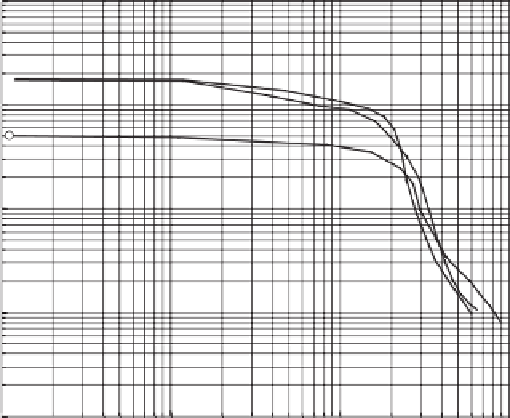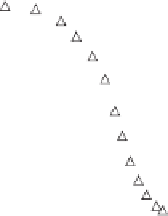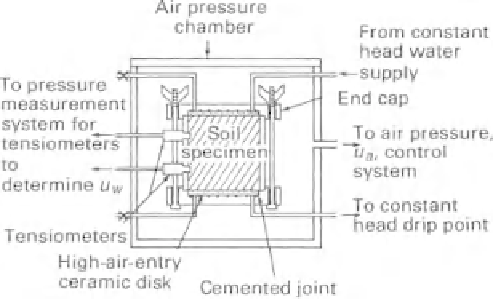Environmental Engineering Reference
In-Depth Information
10
−
6
10
−
7
10
−
8
3
d
= 1.47 Mg / m
3
d
=1.54Mg
ρ
d
= 1.62 Mg / m
10
−
9
ρ
ρ
/ m
3
10
−
10
0.1
1
10
100
Matric suction (
u
a
-
u
w
), kPa
Figure 7.28
Water permeability functions measured using steady-state method (modified from
Ingersoll, 1981).
an extremely accurate mass of water measurements. The
possibility of water loss within the apparatus must be mini-
mized. Air diffusion through the water and water loss from
the apparatus (e.g., plastic container) can cause errors in the
measurements of the volume of water. Air bubbles below
the porous disks must be periodically removed by flushing.
Diffused air inside the tensiometers should also be flushed
from time to time. A diffused air volume indicator can be
used to measure the amount of diffused air in order to
apply the necessary corrections to the water volume change
measurements.
Another testing difficulty is related to the contact between
the soil specimen and the permeameter. As matric suction
increases, the soil specimen may shrink and separate from
the permeameter wall and from the high-air-entry ceramic
plates. The air gap between the soil and the wall of the
permeameter does not allow the seepage of water since air is
nonconductive to the flow of water. Therefore, the separation
of soil from the permeameter wall generally does not create
a serious problem in testing unsaturated soils (Daniel, 1983).
However, a good contact between the soil specimen and the
porous plates is required in order to ensure the continuity
of water flow. The use of loaded porous plates has been
suggested to overcome the problem of separation of the soil
from the porous plates (Elrick and Bowman, 1964; Richards
and Wilson, 1936). It is also important to maintain good
contact between the soil and the tensiometers for accurate
measurements of pore-water pressure.
The use of a high air-entry ceramic disk results in two limi-
tations when attempting to measure the permeability function.
These limitations are shown in Fig. 7.30. First, the soil suc-
tion will be limited by the air-entry value of the ceramic disk.
Figure 7.29
Enclosed and modified Tempe cell used for mea-
surement of water coefficient of permeability using steady-state
method (after Klute, 1965b).
two tensiometers for accurate measurements of pore-water
pressure. The steady-state method requires quite a long time
for testing; however, the results are generally considered to
be more accurate than those from the unsteady-state method
(Hillel, 1982).
7.6.2.4 Limitations and Difficulties
with Steady-State Method
There are several difficulties associated with the steady-state
method (Klute, 1965b, 1972; Olson and Daniel, 1981). The
main difficulty arises from the low coefficient of permeabil-
ity of unsaturated soils, particularly at high matric suctions.
As a result, the water flow rates during the test are extremely
low, and a long time is required to complete a series of
permeability measurements. The low flow rates necessitate




























Search WWH ::

Custom Search